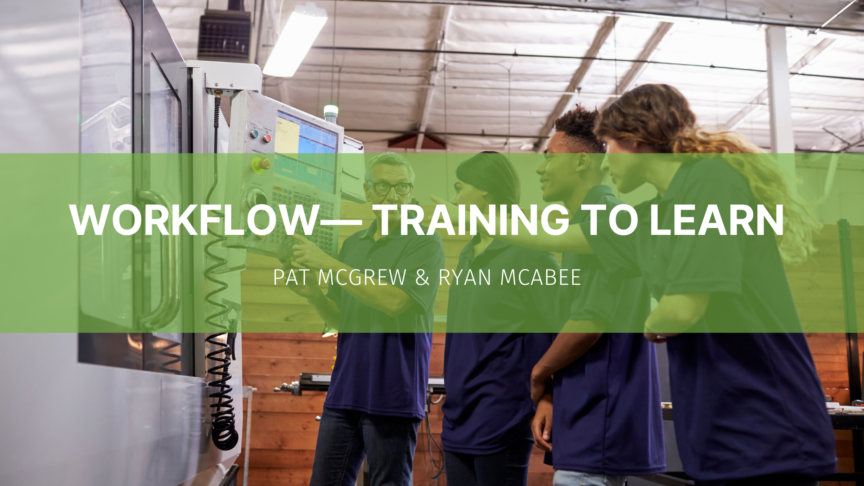Ryan McAbee, Pixel Dot Consulting
Pat McGrew, McGrewGroup, Inc.
A recent Inkjet Insight article laid out the framework to automate your print environment in ten steps. The first step was to understand and scope the business challenge that automation could improve. The guidance was to assess everything from the number of reworks due to misunderstood specifications to missed deliveries. The middle steps continued with identifying the overt and covert processes and implementing the appropriate solutions. The last step framed the importance to test the solution in live production, triage problems that emerge, and then train the team. In this article, let’s focus on training.
First, reframe the term training in your business. Training is not a one-and-done event. It is an adjective describing activities or supporting materials used to impart knowledge and skills. A delivery method is needed to train someone, and usually includes an instructor and educational materials. It may include an online platform if in-person education isn’t available. The goal is for the recipient to learn and use the information proficiently.
Unfortunately, learning is more complex and requires more effort t because each person has their own learning style.
Strive to Reach Different Learning Styles
You may be familiar with the idea that there are visual learners and non-visual learners, and each requires different approaches. In 1987, New Zealand educator Neil Fleming developed the VARK model to represent the four primary learning styles. VARK stands for visual learning, auditory learning, reading and writing, and kinesthetic (by doing) learning. Fleming contended that all learners fall into one of these models. However, a later study in the Journal of Postgraduate Medicine found that most people learn best through a combination of styles. In fact, the auditory/kinesthetic and auditory/read and write are the two most prevalent combinations.
Based on the research, you may want to revamp your approach to training employees. Avoid handing a new employee a software manual and lengthy (often out of date) standard operating procedure (SOPs) binder because the research shows they are ineffective for most – especially for those who are not visual learners. The better approach is to present the relevant material in the two learning style combinations used by most people. Look at your options to record and deliver the training as a video or podcast. It is time to reimagine how you train employees so they can learn and be effective in their roles.
Create a Multitouch Training-to-Learn Program
Before you can create a multitouch training program for employees to learn, you need to identify the learning objectives. Generally, learning is broken into two categories: general knowledge and role-specific knowledge. Learning about the fundamentals and technologies used to print is an example of general knowledge. Learning how to calibrate the printer is an example of role-specific knowledge. To be effective, employees need a basic level of general industry knowledge before role-specific knowledge is overlayed. Ultimately, you need a mix of these just as you need to support the different learning styles.
If you are developing a curriculum, think about the education design and architecture. The requirement is to keep students engaged, impart knowledge, and give them the chance to demonstrate their understanding. As noted, it takes more than a book, a slide deck, or a lecture to ensure everyone is learning. Because of the multitouch nature proscribed by educational best practices today, maintaining an internal educational curriculum can be challenging for print shops of any size. Consider reviewing the resources available in the industry to leverage general knowledge education:
- Inkjet Insight can connect you with experts providing training for sales, management, designers, and print operations professionals for successful inkjet implementations.
- Many print associations and user groups offer targeted courses.
- The Print University, founded by the authors of this article, offers on-demand videos for orientation to production printing.
Role-specific knowledge resources can come in many forms:
- Vendor-supplied classroom training
- Vendor-supplied on-site training
- Vendor-supplied online learning portals
- Internally led, department-level training
- Internally created lunch-and-learns
- Internally created educational video library
- Contracted professional training led by subject matter experts
In addition to online and in-person education opportunities, the best practice is always to set expectations with staff to share knowledge. When staff attend any one-off industry or vendor training, the expectation should be to thoroughly collect and document information for further internal training. With the knowledge and materials in hand, staff can lead internal training sessions and lunch-and-learns.
Another useful approach is to distill the more extensive training sessions into one-page SOPs along with a short video that can be captured with a smartphone and uploaded as a private video on the company’s YouTube channel. These two items work exceptionally well for new hires and temp employees.
Finally, remember that training is a continual process. As your business and production environments change with new processes, equipment, and software, your training and educational materials must also be updated.

